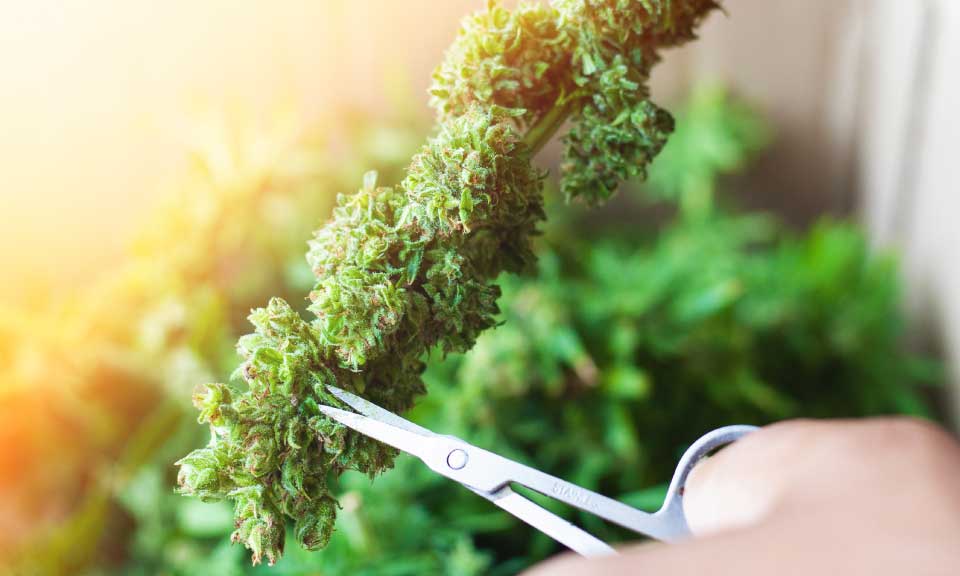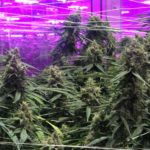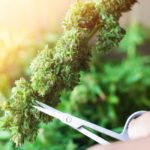
The cannabis curing process for making top-grade weed begins as soon as you cut down a cannabis plant. Apart from great plant genetics, the best way to cure cannabis for top-quality weed products is through a slow dry and long cure. Learning how to cure cannabis is fundamentally important to creating great quality buds to smoke.
By slowly curing bud, we allow natural plant processes to occur, leaving us with a more aromatic and potent end product. Here’s more on how to dry and cure cannabis to improve our weed’s quality and preserve it.
How to Dry Cannabis
The drying stage of curing marijuana involves natural enzymes breaking down the plant’s chlorophyll. To improve the quality of our final product, we must flush the plant’s nutrients before chopping down the plant.
Step 1: Cut down the Cannabis plant
There are a few ways to chop down a cannabis plant to dry its flowers. Some growers chop the entire plant down, while others cut off branches and hang them to dry. In some cases, growers cut down the buds into smaller portions and have them dry on racks or mesh screens.
All of these methods are useful depending on the situation. Some strains of cannabis present unique obstacles, which make it necessary to adjust drying techniques.
For instance, when growing cannabis on a trellis, we find that harvesting a plant by cutting down branches is most efficient. Without a trellis, we would simply cut down the plant as a whole and hang the entire chopped plant.
In the case of auto-flowering cannabis varieties, we might use both options depending on the autoflower’s structure. Meanwhile, some autoflowers grow large, oversized buds. In such circumstances, we would break down the flowers into smaller pieces and dry them on a mesh screen.
Fat flower buds risk mold complications when we leave them on the branch to dry. Separating them from the branch reduces the risk of wasting growing efforts.
Step 2: Trim off extra leaves
Trimming extra leaves improves bud appearance for a smoother experience. Leaving too much leafy matter on a bud can make harsher buds. The least we could do is trim off the large fan leaves and carefully cut off smaller leaves that grow on the flower buds.
Some growers might leave a few smaller leaves untrimmed. It all comes down to personal preference. However, an area’s humidity is a notable factor that we must consider when trimming buds.
- Dry (Below 30% Relative Humidity): Dry areas speed up the drying process, while we aim for a slow drying process. Consider leaving the large fan leaves untrimmed to help slow down the drying process. Leaving more of the plant untrimmed after cutting it down lengthens the drying period.
- Average Humidity: Places where humidity is virtually unnoticeable are the perfect climate to hang cannabis plants upside down to dry. Trimming off leaves is recommended.
- Humid (Above 60% Relative Humidity): Humid areas risk mold, so it is wise to trim off as many leaves as possible. Consider separating buds from branches and drying them on racks or mesh screens to further reduce the chances of mold.
We like to save the extra leaves we trim. These leftovers are resin-covered that can be useful for making cannabis extracts like marijuana butter. The resin from trimming buds is sticky, so be sure to wear disposable gloves when trimming.
Step 3: Slow dry the buds
The best cannabis products need to dry slowly to maintain essential naturally-occurring components. Drying buds too fast may damage the cannabinoids (or chemical compounds) and terpenes (aromatic compounds).
As such, we must avoid quick-drying methods such as using stoves or dehydrators, dry ice, or microwaving buds. Finished products end up smelling and tasting terrible, which may give users migraines. The slow process is the most important part of curing cannabis.
Some key pieces of equipment that growers use to control how long to cure cannabis include the following:
- Air Conditioner: ACs cool the surrounding air in drying rooms and lowers humidity.
- Swamp Cooler: Also known as evaporative coolers, these machines cool air while raising the humidity.
- Dehumidifier: This is useful for humid areas to heat air and lower humidity levels.
- Humidifier: These machines heat air and raise humidity.
- Heater: Heaters typically only heat the air, although they usually lower humidity.
A dry room with a temperature of around 70°F (21°C) and 50% humidity is the ideal environment to optimize the slow drying process. Depending on an area’s natural climate, the above equipment may help get a room down or up to this average humidity level.
Marijuana Drying Methods – The Start of how to cure cannabis
Once we achieve the optimal drying environment, we dry our buds in the different ways we have presented. We use a trellis, although hanging buds upside down using clothes hangers or strings are standard methods of drying.
When separating buds from the rest of the stems, we use drying racks to help dry our buds faster. Stems can sometimes contain traces of water. This technique is helpful for humid areas where mold threatens to grow.
Another drying method that growers use is laying their harvested buds flat on cardboard. This may create wet spots that imprint on the buds’ sides upon touching the flat surface. These wet spots call for constant rotation, perhaps every few hours, to allow more even drying.
Small fans can help control the airflow in humid areas to prevent mold from forming due to a wetter environment. Avoid pointing fans directly at drying buds to maintain the slow drying process. Consider pointing a small fan at a nearby wall away from the drying crops.
We want to avoid drying out our cannabis too fast or too slow. We can determine that the flowers are dry enough to be jarred once they are crisp on the outside (but not brittle) and the smaller stems snap when bent. This process usually takes three days to a week.
The buds during this time may appear too dry. Check if the larger stems remain bendy, meaning they still contain some traces of water. This water slowly works its way out of the buds during the curing process.
Virtually dry buds with trace moisture from the stems signify the perfect time to pull down the buds and put them into jars. Meanwhile, the buds that we completely remove from the stem are ready to jar as soon as they are dry to the touch.
How to Cure Cannabis in Glass Jars
Once the buds are dry enough, we can proceed with the curing process by placing them in jars. We must achieve a stable relative humidity (60%-65%) within the enclosed container to achieve perfection. This is possible if we jar the buds as soon as they are dry to the touch with the larger stems still bendy.
Using hygrometers helps us maintain the optimal range for humidity inside the jars. Hygrometers are cheap and effective items that help take the guesswork out of the entire curing process. With hygrometers, we can confirm whether the humidity inside jars remains between 60 and 65 percent.
When it comes to jars, we use standard mason jars in a few different sizes depending on the amount of plant yield. Consider 1.9-liter wide mouth mason jars with snap lids to store marijuana buds. These containers are available at big grocery stores, craft stores, and online stores.
These jars can easily fit about two ounces of bud, or up to three ounces depending on bud structure. Some growers of the girl scout cookies strain may produce rock-hard buds and can fit up to three ounces in one of these jars.
The airtight seal is the most important factor to consider when choosing a container to cure bud in. The environment in the jar affects the curing process. It has to be stable enough for the enzymes to break down properly, which cannot happen unless the environment is controlled and maintained over a long time.
When the bud is in a jar with a stable humidity between 60 and 65 percent, the “sweating” process of curing starts. During this time, we must remove excess moisture by slowly drying out the bud. To do this, we open the lids and “burp” the jars a few times a day in the first week. Burping the jars keeps the oxygen content within the jar fresh.
Should the hygrometers read above the optimal humidity range, consider removing the flower buds from the jars. Lay them on a drying rack or screen to air out for about an hour or so before returning them to the jars. We continue this process for a few weeks until we burp the jars less frequently.
We find that it takes around a month before strong aromas puff when we open the lids. When this happens, the curing process has done enough to make the bud ready to smoke. However, most cannabis cup winners undergo six-month cures.
Longer curing periods require more time to maintain the right moisture levels in the buds. To help achieve this, two-way humidity control packs are useful. These devices are only necessary after a few weeks when hygrometers drop below the ideal humidity range. Using them at the start may affect the flowers’ flavor and aroma.
How to Inspect Buds Curing in Jars
Burping jars is important to make sure no mold or bacteria forms from too much moisture in the jars. Consider checking more than once a day, especially in the beginning stages of the curing process.
Buds that feel moist or have any scent of ammonia need time to air out before sealing them again. We want to maintain a cannabis smell every time we open the jar. Hygrometers help us check the accurate humidity levels and then adjust accordingly if we notice that the buds feel a certain way:
- If the buds feel wet: We must remove the bud from the jar and allow them to dry for up to two hours. We make sure that no wet buds touch each other. Should any bud feel damp when touched, the likelihood of mold growth is high, prompting immediate action.
When hygrometers read more than 70% humidity, buds are too wet. This calls for more frequent jar opening. Consider keeping a closer eye on the buds to avoid leaving them any more moist than they probably are.
- If the buds feel moist: Leaving them in the jar with the lid off for about half an hour helps restore the curing process. Buds that are a bit too damp risk anaerobic bacterial growth, so taking the lid off helps air out the buds to feel dry again.
Slightly moist buds may stick together, with the hygrometer reading between 65% and 70% relative humidity after leaving the bud in the jar for a day.
- If the buds are dry: This is the cure zone. When buds are not wet, yet not brittle either, buds may feel a bit sticky to the fingers. This is easy to confirm by shaking the jar and checking how the buds move. If buds move freely and do not clump in big bunches, the buds are curing regularly.
In the cure zone, leaving buds in a jar with a hygrometer for a day will have 60% to 65% relative humidity. Some growers use moist packets to bring down the humidity to 55%, especially when they cure large batches of cannabis.
- If the buds are brittle: Crumbly buds need a bit more moisture to continue the curing process. When buds are brittle, leaving them alone or rehydrating with a humidifying pack can help the curing process return to a normal pace.
Buds are too dry when hygrometers read under 55% relative humidity. Should this happen, try leaving the buds alone for up to three days before taking any further action. Chances are, there is still some moisture within the buds. Should the buds remain dry after three days, consider rehydrating.
Humidity packs help bring jar humidity back to the optimal curing range without affecting the taste and aroma. Simply remove the pack from the jar when the humidity levels have stabilized in the optimal range.
How to Store Cured Cannabis
Cured buds continue improving from the curing process for up to six months. Keeping the buds in the cure zone beyond six months may not have much effect. In this case, we must prepare the buds for long-term storage.
To store cured cannabis for the short-term (under six months), we must keep them in air-tight containers and store them in a cool and dark environment, away from direct sunlight. To go beyond six months of storage, consider storing buds in vacuum-sealed containers and keeping them in freezers.
Buds are only ideal for long-term storage if they are dry and have been curing for at least three months. If buds are too dry, avoid any intention of storing them for a long time without regularly checking in on the buds.
Properly stored cured cannabis may retain its potency for years. Buds that have been curing for over a year after harvest may appear beige and likely produce mellow effects. Should the buds get brittle, humidity control packs can help rejuvenate the bud.
Hygrometers read about 62% relative humidity, which is the indication that buds are dry enough for long-term storage. The buds must be dry to avoid any mold formation. Consider leaving a jar unopened for a few weeks to reach an accurate and optimal humidity reading.
the process of Curing cannabis
Learning how to cure cannabis is a long process that involves careful planning and maintenance. The best weed products always go through a slow drying process and a long curing process, which begins as soon as chopping the plant down.
There are different ways to dry harvested cannabis, which all depend on the environment and the kind of cannabis plant. Still, the traditional method of hanging the plants upside down to dry is an ideal drying method.
Curing involves the natural enzymes within cannabis plants to break down chlorophyll to make sure the final product is top-shelf. This curing process best occurs slowly, which needs constant attention and a stable environment. Fortunately, there are many pieces of equipment that help growers maintain a controlled environment that is suitable for curing cannabis.





